
Полная версия
Street Knowledge
The other side of Asbestos’ art is his Lost Series of stickers and posters that advertise random missing objects that are lost but may not need to be found.
‘This series has been a constant in my work over that last few years and provides me with a bizarrely fun outlet to interact with the public. I’m constantly getting amused and bemused mails from people who’ve spotted the stickers to tell me that they’ve found what’s lost or that they hope I find one of my errant objects.’


JONAS ÅKERLUND
www.raf.se
Jonas Åkerlund is one of the world’s most visionary and consistently innovative film directors. He’s created some of the greatest, most memorable music videos for the likes of The Prodigy, Madonna, Blink 182, The Smashing Pumpkins and Ali-G (respect!) and made the transition to the big screen seamlessly with his debut feature Spun — a film so dope that it made me want to start taking drugs again (after being totally clean for at least five years) when I last watched it! His Swedish sensibilities ensure that his work is always original, and bacon-sandwich-droppingly controversial. Way back when, Jonas happened to be working for a production company when he was presented with an opportunity to step up his game.
‘I was working in other areas of production when Swedish TV went commercial. We were one of the last countries in the world to have commercial TV and when it happened every company wanted a commercial. So I just started shooting commercials. It was the most natural thing for me to do.’
He then began to make commercials in Europe and then gradually moved into music videos, which is where he found worldwide fame. He blew up with his brilliant and controversial ‘Smack My Bitch Up’ video, which is still the greatest music video — ever.
‘I think being Swedish I have a different shock level than the rest of the world, so I honestly try and bend the rules. I know that you can’t show certain things. With the Prodigy video, the most shocking thing was how big it became. This was before the Internet so everyone was passing around videotapes. Everyone saw it you know, Jay Leno made jokes about it on his show for five nights in a row… It was the first time that I made something that seemed to affect people…’
I kinda wonder if the music video is still relevant now as it was back inna day, when MTV ruled supremely. I ask Jonas if he still feels the same when he is making the videos today as he was back then.
‘I still enjoy making music videos but the problem I have is that everyone is worried about the content. There used to be a time when the videos were creative and free from all red tape, the brief was ‘just do something that we haven’t seen before, something that sticks out that people talk about’. And today the brief is that it’s gotta be ‘Iconic’. Making music videos has recently become a bit more like doing a commercial, but with an inexperienced client. The thing with advertising agencies is that they know what they are talking about. They know their audience. With the music world they are all smart-asses who all think they know what they’re talking about — but they really don’t. Out of that inexperience comes great creativity, that’s why I still love it!’
Back in 2002 when he made Spun, no one would even send Mickey Rourke a script, let alone cast him in a movie; he was seen as box-office poison by the fools who run the show, but Jonas ignored all this bullshit and cast him as ‘The Cook’ — one of Mickey’s finest roles to date. I give him total respect for that action alone. Jonas has recently completed shooting a $25m horror film, Horsemen, and continues to create amazing music videos and commercials around the world.



ADVERTiSiNG
So I may be a bit biased (as I used to be an art director, hence the ADZ in my name) but advertising has had a massive influence on street culture and vice versa. In terms of audio/visual culture, adverts are not only massively influenced by street shit (usually they are always playing catch-up to what is really happening on the street), they also, once in a while, influence it. Okay, so right now the advertising industry is in a bit of a strange place as the Internet came along and changed everything. The web is a showcase of original ideas, created by everyone and anyone — it totally changed the way ad agencies worked, who were no longer an exclusive source of creative genius anymore.
Back inna day a full-scale ad campaign to launch a new product consisted of a couple of press ads, some outdoor and — the king of ads — a TV spot or two. Now all that has changed but some of advertising’s most respected players — and my personal heroes (Tony Kaye, Oliviero Toscaniro) — have made their names in advertising before moving on to bigger and better things. Take for instance the legendary Dunlop-Tested For The Unexpected TV ad from 1993, an advert that totally changed the face of how TV ads were made and watched. The most amazing visuals (an S&M mask-clad man, a grand piano on wheels driving across a bridge, black ball bearings), cut to a Velvet Underground song, it blew the genre apart. It showed that elements of street culture (the ad was drenched in pure street style and attitude) could be harnessed and used in the mainstream media without having to use the obvious images of things like break dancing youths. This ad was light years ahead of the game, and in turn influenced music videos, film which in turn had a direct influence on street culture.
‘The Dunlop TV ad was an incident where the stars all came together at the same point. I was working with a creative team from an ad agency Tom Carty and Walter Campbell — and they trusted me completely. I’d just come off making a terrible British Airways commercial which really went completely wrong, so I said to them, and their client — “If you want me to do this for you then you have to back off and let me do my thing otherwise I won’t be able to give you what you really want.” And they all did. Originally that script was “Open on a big frying pan with a car driving round the frying pan and it’s got these tyres.” That was what their idea was. And we completely changed it and got something out on TV that if it ran next week, it would be as radical as it was then.’
Tony Kaye
Advertising has now become an integral part of the street culture, as a lot of the new campaigns are what’s called ‘guerrilla’ — stuff that actually happens in the street, events that people can interact with and not merely watch. Advertising has become harder and harder to spot within the urban environment. Brands are hosting events, exhibitions, star-maker competitions, websites, publishing magazines, all of which appear to be non-branded, but are actually just vehicles for an energy drink, sneakers, or a pair of jeans, often using imagery, techniques and other ideas lifted directly from the sub-culture of the street. Sony executed a campaign where they used street artists in Berlin to advertise their PSP, much to the scorn of the Berlin public who worked out what was going on (they were being sold to by a huge corporation) immediately as the ‘street art’ went up. It didn’t matter how good the street art was, it was dismissed as it was just advertising.
But that said, advertising is part of the day-to-day whether we like it or not. There are direct lines of influence between street culture and advertising, but more recently it has been a one-way street with street culture (including its online presence) being absorbed, regurgitated and then spat out as advertising. This will change as society is always hungry for the ‘new’ and in the not-too-distant future it will be the turn of advertising to carry this torch.

ALiFE
www.alifenyc.com
The purest attitude and motives go into the creation of their constantly amazing clothing range and other amazing products and projects. Alife is the strongest brand that’s come out of the New York bombing movement. Alife started out as a creative space on Orchard Street in the Lower East Side. They chose this spot as 1) it was affordable and 2) it was an area that people from all the other boroughs of Manhattan would not be opposed to coming to. Coming out of bombing you have to think about this shit! I sat down with Rob Cristofaro the founder of Alife.
‘I used to write graffiti and I decided to start this new thing — workshop, retail space — I guess it was a store but never had any experience doing any of that shit. Me and a few other dudes were like “we’re gonna start something” as there wasn’t anything going on. We started the plans in 1998 and by ‘99 we found the space and opened up shop in the Lower East Side, Orchard Street, which was basically at the time affordable rent as nobody was really down there. We didn’t know what the hell we were doing and were just like “fuck it, let’s just try this new jump-off and see where it goes.“’
Once they opened the space, Alife became their new tag and their mission was to get the name out there in any way possible: stickers, T-shirts, magazines, the same shit as usual; self-promotion is all bombing really, with no budget. They don’t pay for advertising and everything is hand done, independent street promotion. That’s not to say that if they had a big budget to go do some serious marketing, they would be going large on billboards, as I’m sure they’d still retain that no-budget attitude.
‘That’s the graffiti way — it’s like, “king, shit, fuck everybody else; fuck all crews, we’re by ourselves, no respect for really anybody else out here,” and that’s our shit: We’re gonna king New York. Alife was based on the street and before we opened our space we put the word out to the graffiti community — who were the only people we were in touch with — that we were opening a platform, a workshop, a creative space, and we wanted them to be involved. We had a meeting before we opened the store with 50-60 people. These were all the creative people before the shit became what it is. This was people like Espo, Reese, Kaws, the people that were graffiti writers but ready to take it to the next level and at the time there was no other venue for it.’
At this time there wasn’t any commercial side to the graffiti movement, and Alife has been based on the art side of things from the beginning. Back then they didn’t make clothing, they didn’t do footwear — just a space for art, and after they had made enough noise from that, did they think about producing clothing and everything else that they do now.
‘Everything that we’ve done has been a learning experience from having no experience of owning a business to running businesses and independently promoting all the shit that we do. And then having big corporations come and, like, mimic the shit that we’re doing but with big fucking budgets. Once in a while there is some interesting shit that goes on out there, and the people that evolve and are not following any shit, any trend — that’s the kind of people we like to involve ourselves with. Where I see us going is hopefully the money is going to get bigger and with the bigger budget do more powerful, widely seen things for the public. Using the clothing and the footwear to bring the money in to do the shit that we really like to do — the creative shit.’
Wherever Alife is going you can be sure of one thing: that Alife will continue to create and produce art clothing whatever, with a real connection to the streets from which it came — New York City streets, and that is the one place that is King of street culture.

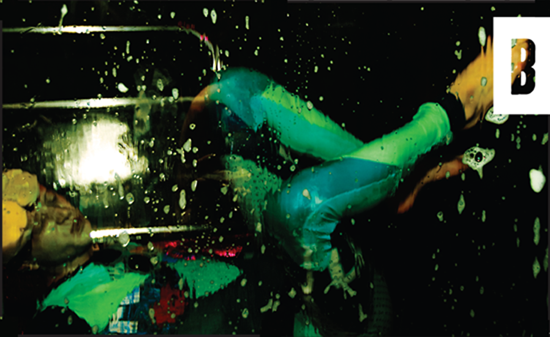
BANKSY
www.banksy.co.uk
Back in the 1980s when graffiti was just crossing over into the New York downtown art scene, somewhere in Bristol, some kid called Robin was going to school and having fun. Years later, mirroring the past (just like the old-school New York graffiti ‘writers’), Banksy began his career as a graffiti writer and attempted to get up on every wall of the borough of Easton, where he was from. The Banksy juggernaut began rolling with his first ever exhibition, which was held in a block of council flats. He sold four canvases to the band Massive Attack. He then progressed to using stencils, as it was a lot quicker to apply and created a harder impact, something that has always been important for his work. A well hard impact! And the resulting attention to detail is one reason why Banksy is responsible for the popularity of street art right now. He is the undisputed leader of the movement and his work is by far the wittiest, most accessible of any artist of the last 50 years. This is because everyone gets it. He gets up somewhere and the resulting piece makes the front page of newspapers all over the world because the work is beautiful, topical, cheeky and extremely accessible.
Although Banksy hails from Bristol, his artistic home is the streets of London (and later LA, New York, New Orleans, Bamako and the West Bank) for it was here that he built up his name with his stunts such as installing his illegal 25-ton statue opposite the Law Courts, or stickering police cars with ‘Legal Graffiti Zone’ written on them. Shows from Shoreditch to Mayfair showcased his unique brand of street art. Banksy is undoubtedly responsible for the rise of the art movement, as he has taken graffiti out of the streets and into the hearts and minds of the public with his witty, spot-on pieces all over the world. No-one would be making a living off their street art if it wasn’t for Banksy.

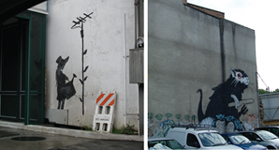
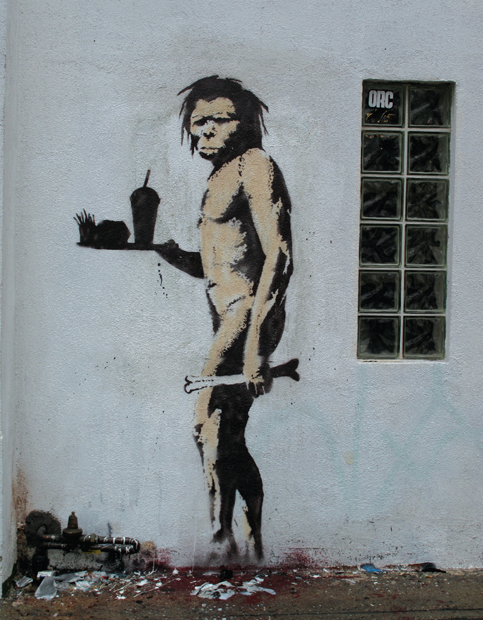
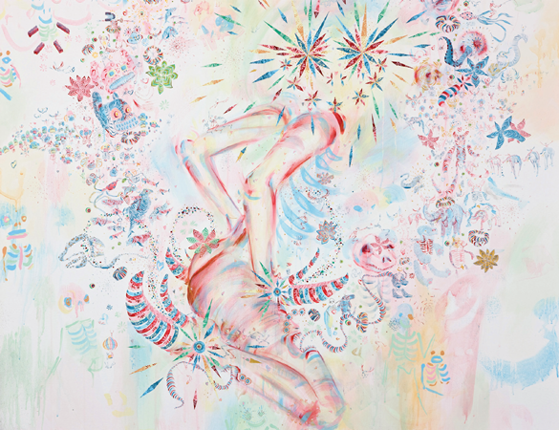
KELSEY BROOKES
www.kelseybrookes.com
Kelsey is a contemporary painter whose work has been inadvertently influenced by the street. I first met Kelsey when he was working as a scientist in some lab in San Diego and had tracked him down as I wanted to show his killer work in ‘1 percent’, a free online PDF that I used to edit all about urban creativity. He was doing something completely different and fresh, and was a sweet, out-there guy. I then ran ‘The 92024 Report’ in which Kelsey would tell us about his life on the West Coast in Issue 3 but the column never really developed, as it was the last ever issue of the mag.
So eight years later he’s blown up and is a full-time fully paid-up member of the global artistic community, and having exhibitions around the world. Couldn’t have happened to a nicer guy.
‘My work is about what I see when I close my eyes. It is about spirituality and the unknown. Others are calling it “Neo Shamanistica”, I call it what I do when I’m not eating. It’s evolved by means of random mutation and natural selection. In this case I am both the mutation and the selection, which really accelerates and distorts the evolutionary process.’
NiNA BRAUN
www.ninabraun.net
Some crazy shit going on here. Nina creates art by using tactile, unusual techniques such as knitting and sewing. It’s totally fresh and I love it. Nina Braun is a European artist who was born in Italy and then raised mainly in Germany near Cologne by a Dutch mother and a German father. She had a good childhood moving a few times as a kid, living in the Netherlands and Hamburg, with the result that today she doesn’t feel rooted to any one place. She now lives and works in Berlin.
‘I love to mix supposedly outmoded handcraft techniques with contemporary matters. I take the liberty to explore different materials and processes. I produce sculptures, installations, textile pictures and paintings, objects and cartoons.’
Back inna day she studied Visual Arts at art school in Hamburg.
‘It was there that I received the impression that art is not allowed to be fun and should not be pleasing to look at. I left the academy before the exams, partly disappointed, but partly for the benefit of (skateboarding company) Sumo, that expanded with rapid strides back then. My “education” continued on the streets and I improved my skills in urban disciplines. I finally entered the ‘real’ art world, but I keep my background—urban culture — visible in my work by using an iconic picture language and characters to tell my stories.’
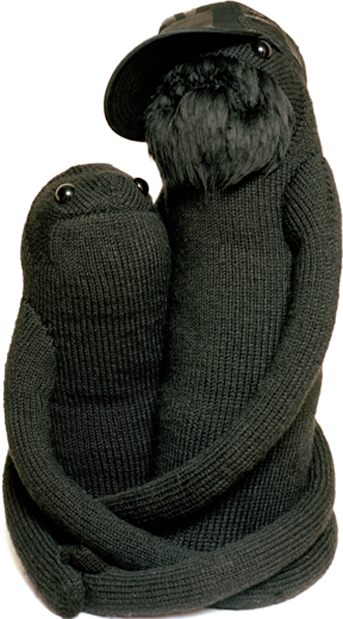
BERLiN
Berlin has been one the finest cities for the urban generation for the last ten years and will continue to do so for some time, as in the grand scheme of things Berlin is a total infant as it has only been one city since 1989. The streets are plastered with graffiti and street art (only recently outlawed) and the Kreuzberg, Friedrichshain, and Prenzlauer Berg areas are where it’s at for street life. This is where the young and the restless hang and the great-quality, cheap places to eat, sleep and drink are in abundance.
Because of the number of youth in the city there is a lot of cheap entertainment on offer. There are too many clubs and venues even to think about listing and every genre of music is catered for. In the Kreuzberg and Friedrichshain neighbourhoods there are many small bars that open up and attract boho crowds that are seriously unique. This is the place where the doner kebab was invented. Forget what you know about the doner, in Berlin they are one of the most delicious things you can eat.
A short walk from the Ostkreuz station is a really great street called Sonntagstrasse, which is a great place to spend an evening. A lot of students live in this area as it is cheap and not-yet developed. There are a few hostels and cheap hotels here and many bars and restaurants.
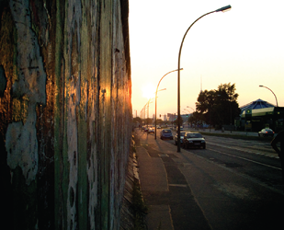
The Mitte area has been almost completely rebuilt since 1989 as this was where the wall ran its course with large parts mainly no-man’s land between East and West Berlin, and a lot of the fashion industry and boutique hotels are situated here.
One thing that is interesting about Berlin is the courtyards behind the tall apartment buildings. There is a whole world waiting to be explored and most courtyards are accessible to the public. You can be on the most urban street and wander through the heavily graffiti’d arch, then step into another world: ponds, trees, timber yards, artists’ studios, kindergartens, communal eating and living spaces, indie cinemas. There are some great independent festivals and events in and around the city, especially in the summer when the city comes alive. The Berliners love their independence and when the 02 stadium was built recently there was much protesting at the homogenization of their culture, with a lot of the city promising to boycott any concert there. Here here! I say. Fight the power and commercialization of culture.
There isn’t much left of the wall except for the tourist area in the Potsdammer Platz and the West Side gallery along the river in Kreuzberg. The latter is the one to visit as a lot of the original wall art is still visible and this tells its own story of the wall.
BERLiN ON LESS THAN 40 EUROS A DAY
Berlin is one of the cheapest western European cites. The figures below will change slightly with inflation, but this is what you can live off:
Dorm bed in decent hostel €16 Continental Breakfast €2 Lunch (doner/pizza) €2.50 Supper (quality) €7 Travel Card €6.10 Drinks (ten bottles of beer/soda) €5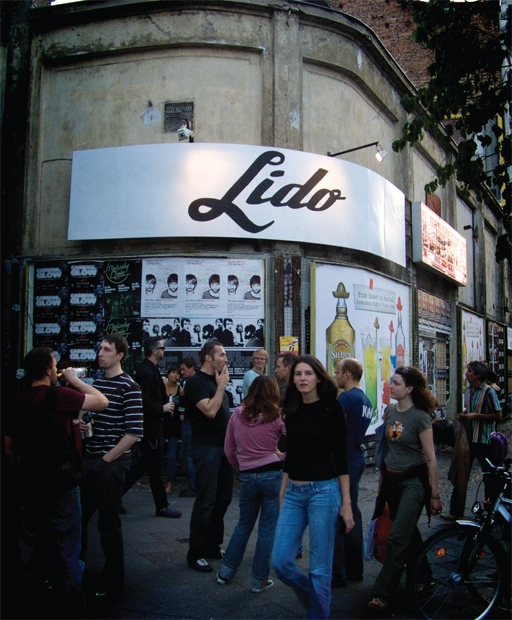

BROKEN FiNGAZ
www.brokenfingaz.com
I drive 90 km north of Tel Aviv to the city of Haifa. On the way I pass gas stations with giant dragons sat on the roof breathing neon fire onto the peeps filling up their cars and state-of-the-art shopping malls and entertainment complexes. There is nothing backwards about Israel, even out of the cities. I’m in Haifa to hang out with the Broken Fingaz, a multi-faceted, multi-talented, young and restless art and music crew who virtually run the street scene in Haifa single handedly. And after I marvel at their fucking cool shop in the mixed Massada area, they take me downtown to the Arab part of town for some killer hummus.
‘We attempt to recreate our personal twisted world into our art. Most of the time what comes out is a lot of colors, organs, fat people and animals on acid. We started as part of the first generation of graffiti writers in Israel at the beginning of the decade. Five years ago we started a line of underground parties, and designed all the posters and flyers for the events. That was our first serious experience with graphic design, and slowly we started to design most of the flyers and posters for parties and shows in Tel Aviv. From there we evolved to other media such as T-shirts and plush dolls, screen prints, fine art and eventually opening our own gallery and shop, keeping it DIY at all times.’
Not only do they design the posters, they host the events in Haifa and then promote the shit outta whatever, as they believe in what they do. It’s been a while since I’ve met such an enthusiastic and energized bunch of kids, and this is a breath of fresh air for street culture.
‘Street culture means having an edge, style, being a part of your local community. It’s about putting your shit outside, not only through the media and the web. The fact that street art gets so hyped these days just makes it possible for us to actually make a living from stuff we like doing anyhow.
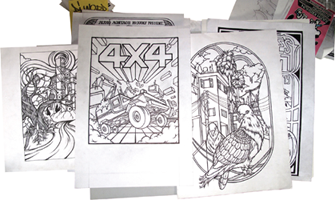
‘We grew up in Haifa City, a true old school town. It’s like San Francisco of the Middle East, only without the hipsters and the gays, just the homeless and the old hippies. On one hand growing up in this gypsy town made it hard to be exposed to many things we liked in this culture; on the other hand, being a pioneer and playing on fresh ground made the game much more self motivating and gave us the opportunity to see the scene growing from zero to really cool and artistic.


